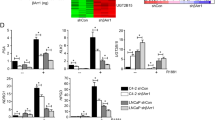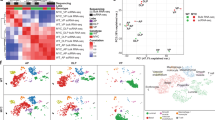Abstract
Androgen receptor (AR) has essential roles during prostate cancer progression. With genome-wide AR-binding sites mapped to high resolution, studies have recently reported AR as a transcriptional repressor. How AR inhibits gene expression and how this contributes to prostate cancer, however, are incompletely understood. Through meta-analysis of microarray data, here we nominate nephroblastoma overexpressed (NOV) as a top androgen-repressed gene. We show that NOV is directly suppressed by androgen through the AR. AR occupies the NOV enhancer and communicates with the NOV promoter through DNA looping. AR activation recruits the polycomb group protein EZH2, which subsequently catalyzes histone H3 lysine 27 tri-methylation around the NOV promoter, thus leading to repressive chromatin remodeling and epigenetic silencing. Concordantly, AR and EZH2 inhibition synergistically restored NOV expression. NOV is downregulated in human prostate cancer wherein AR and EZH2 are upregulated. Functionally, NOV inhibits prostate cancer cell growth in vitro and in vivo. NOV reconstitution reverses androgen-induced cell growth and NOV knockdown drives androgen-independent cell growth. In addition, NOV expression is restored by hormone-deprivation therapies in mice and prostate cancer patients. Therefore, using NOV as a model gene we gained further understanding of the mechanisms underlying AR-mediated transcriptional repression. Our findings establish a tumor-suppressive role of NOV in prostate cancer and suggest that one important, but previously underestimated, manner by which AR contributes to prostate cancer progression is through inhibition of key tumor-suppressor genes.
This is a preview of subscription content, access via your institution
Access options
Subscribe to this journal
Receive 50 print issues and online access
$259.00 per year
only $5.18 per issue
Buy this article
- Purchase on Springer Link
- Instant access to full article PDF
Prices may be subject to local taxes which are calculated during checkout






Similar content being viewed by others
Accession codes
References
Lamont KR, Tindall DJ . Minireview: alternative activation pathways for the androgen receptor in prostate cancer. Mol Endocrinol 2011; 25: 897–907.
Yu J, Mani RS, Cao Q, Brenner CJ, Cao X, Wang X et al. An integrated network of androgen receptor, polycomb, and TMPRSS2-ERG gene fusions in prostate cancer progression. Cancer Cell 2010; 17: 443–454.
Lin B, Wang J, Hong X, Yan X, Hwang D, Cho JH et al. Integrated expression profiling and ChIP-seq analyses of the growth inhibition response program of the androgen receptor. PLoS One 2009; 4: e6589.
Massie CE, Lynch A, Ramos-Montoya A, Boren J, Stark R, Fazli L et al. The androgen receptor fuels prostate cancer by regulating central metabolism and biosynthesis. EMBO J 2011; 30: 2719–2733.
Wang D, Garcia-Bassets I, Benner C, Li W, Su X, Zhou Y et al. Reprogramming transcription by distinct classes of enhancers functionally defined by eRNA. Nature 2011; 474: 390–394.
Cai C, He HH, Chen S, Coleman I, Wang H, Fang Z et al. Androgen receptor gene expression in prostate cancer is directly suppressed by the androgen receptor through recruitment of lysine-specific demethylase 1. Cancer Cell 2011; 20: 457–471.
Zhao JC, Yu J, Runkle C, Wu L, Hu M, Wu D et al. Cooperation between polycomb and androgen receptor during oncogenic transformation. Genome Res 2012; 22: 322–331.
Liu YN, Liu Y, Lee HJ, Hsu YH, Chen JH . Activated androgen receptor downregulates E-cadherin gene expression and promotes tumor metastasis. Mol Cell Biol 2008; 28: 7096–7108.
Verras M, Lee J, Xue H, Li TH, Wang Y, Sun Z . The androgen receptor negatively regulates the expression of c-Met: implications for a novel mechanism of prostate cancer progression. Cancer Res 2007; 67: 967–975.
Lanzino M, Sisci D, Morelli C, Garofalo C, Catalano S, Casaburi I et al. Inhibition of cyclin D1 expression by androgen receptor in breast cancer cells—identification of a novel androgen response element. Nucleic Acids Res 2010; 38: 5351–5365.
Jun JI, Lau LF . Taking aim at the extracellular matrix: CCN proteins as emerging therapeutic targets. Nat Rev Drug Discov 2011; 10: 945–963.
Martinerie C, Viegas-Pequignot E, Guenard I, Dutrillaux B, Nguyen VC, Bernheim A et al. Physical mapping of human loci homologous to the chicken nov proto-oncogene. Oncogene 1992; 7: 2529–2534.
McCallum L, Price S, Planque N, Perbal B, Pierce A, Whetton AD et al. A novel mechanism for BCR-ABL action: stimulated secretion of CCN3 is involved in growth and differentiation regulation. Blood 2006; 108: 1716–1723.
Ohgawara T, Kubota S, Kawaki H, Kurio N, Abd El Kader T, Hoshijima M et al. Association of the metastatic phenotype with CCN family members among breast and oral cancer cells. J Cell Commun Signal 2011; 5: 291–299.
Zuo GW, Kohls CD, He BC, Chen L, Zhang W, Shi Q et al. The CCN proteins: important signaling mediators in stem cell differentiation and tumorigenesis. Histol Histopathol 2010; 25: 795–806.
McCallum L, Irvine AE . CCN3—a key regulator of the hematopoietic compartment. Blood Rev 2008; 23: 79–85.
Perbal B . CCN3: Doctor Jekyll and Mister Hyde. J Cell Commun Signal 2008; 2: 3–7.
Benini S, Perbal B, Zambelli D, Colombo MP, Manara MC, Serra M et al. In Ewing's sarcoma CCN3(NOV) inhibits proliferation while promoting migration and invasion of the same cell type. Oncogene 2005; 24: 4349–4361.
Maillard M, Cadot B, Ball RY, Sethia K, Edwards DR, Perbal B et al. Differential expression of the ccn3 (nov) proto-oncogene in human prostate cell lines and tissues. Mol Pathol 2001; 54: 275–280.
Ouellet V, Tiedemann K, Mourskaia A, Fong JE, Tran-Thanh D, Amir E et al. CCN3 impairs osteoblast and stimulates osteoclast differentiation to favor breast cancer metastasis to bone. Am J Pathol 2011; 178: 2377–2388.
Fukunaga-Kalabis M, Martinez G, Telson SM, Liu ZJ, Balint K, Juhasz I et al. Downregulation of CCN3 expression as a potential mechanism for melanoma progression. Oncogene 2008; 27: 2552–2560.
Sin WC, Tse M, Planque N, Perbal B, Lampe PD, Naus CC . Matricellular protein CCN3 (NOV) regulates actin cytoskeleton reorganization. J Biol Chem 2009; 284: 29935–29944.
Vallacchi V, Daniotti M, Ratti F, Di Stasi D, Deho P, De Filippo A et al. CCN3/nephroblastoma overexpressed matricellular protein regulates integrin expression, adhesion, and dissemination in melanoma. Cancer Res 2008; 68: 715–723.
Fu CT, Bechberger JF, Ozog MA, Perbal B, Naus CC . CCN3 (NOV) interacts with connexin43 in C6 glioma cells: possible mechanism of connexin-mediated growth suppression. J Biol Chem 2004; 279: 36943–36950.
Jiang WG, Watkins G, Fodstad O, Douglas-Jones A, Mokbel K, Mansel RE . Differential expression of the CCN family members Cyr61, CTGF and Nov in human breast cancer. Endocr Relat Cancer 2004; 11: 781–791.
Bohlig L, Metzger R, Rother K, Till H, Engeland K . The CCN3 gene coding for an extracellular adhesion-related protein is transcriptionally activated by the p53 tumor suppressor. Cell Cycle 2008; 7: 1254–1261.
Kimura A, Martin C, Robinson GW, Simone JM, Chen W, Wickre MC et al. The gene encoding the hematopoietic stem cell regulator CCN3/NOV is under direct cytokine control through the transcription factors STAT5A/B. J Biol Chem 2010; 285: 32704–32709.
Bao BY, Chuang BF, Wang Q, Sartor O, Balk SP, Brown M et al. Androgen receptor mediates the expression of UDP-glucuronosyltransferase 2 B15 and B17 genes. Prostate 2008; 68: 839–848.
Wang Q, Li W, Liu XS, Carroll JS, Janne OA, Keeton EK et al. A hierarchical network of transcription factors governs androgen receptor-dependent prostate cancer growth. Mol Cell 2007; 27: 380–392.
Yu J, Cao Q, Mehra R, Laxman B, Yu J, Tomlins SA et al. Integrative genomics analysis reveals silencing of beta-adrenergic signaling by polycomb in prostate cancer. Cancer Cell 2007; 12: 419–431.
Yu J, Cao Q, Yu J, Wu L, Dallol A, Li J et al. The neuronal repellent SLIT2 is a target for repression by EZH2 in prostate cancer. Oncogene 2010; 29: 5370–5380.
Wang XD, Wang BE, Soriano R, Zha J, Zhang Z, Modrusan Z et al. Expression profiling of the mouse prostate after castration and hormone replacement: implication of H-cadherin in prostate tumorigenesis. Differentiation 2007; 75: 219–234.
Best CJ, Gillespie JW, Yi Y, Chandramouli GV, Perlmutter MA, Gathright Y et al. Molecular alterations in primary prostate cancer after androgen ablation therapy. Clin Cancer Res 2005; 11: 6823–6834.
Yu J, Rhodes DR, Tomlins SA, Cao X, Chen G, Mehra R et al. A polycomb repression signature in metastatic prostate cancer predicts cancer outcome. Cancer Res 2007; 67: 10657–10663.
Welsbie DS, Xu J, Chen Y, Borsu L, Scher HI, Rosen N et al. Histone deacetylases are required for androgen receptor function in hormone-sensitive and castrate-resistant prostate cancer. Cancer Res 2009; 69: 958–966.
Joliot V, Martinerie C, Dambrine G, Plassiart G, Brisac M, Crochet J et al. Proviral rearrangements and overexpression of a new cellular gene (nov) in myeloblastosis-associated virus type 1-induced nephroblastomas. Mol Cell Biol 1992; 12: 10–21.
Wang Q, Li W, Zhang Y, Yuan X, Xu K, Yu J et al. Androgen receptor regulates a distinct transcription program in androgen-independent prostate cancer. Cell 2009; 138: 245–256.
Grasso CS, Wu YM, Robinson DR, Cao X, Dhanasekaran SM, Khan AP et al. The mutational landscape of lethal castration-resistant prostate cancer. Nature 2012; 487: 239–243.
Acknowledgements
We thank Dr Bernard Perbal (University of Paris) for the K19M anti-NOV antibody, Dr Kurt Engeland (Universitätsfrauenklinik Leipzig) for the NOV constructs, Dr Raymond Bergan for the PC-3M cells, and Dr Stephen Plymate for AR overexpression constructs. We are also grateful to Jonathan Zhao and Jung Kim for technical assistance. This work was supported by funding from the NIH P50CA090386 (to CL, JY), U54CA143869 pilot project (to JY), K99/R00CA129565 (to JY), R01HG005119 (to JY), the US Department of Defense W81XWH-09-1-0193 (to JY) and the Research Scholar Award RSG-12-085-01 (to JY) from the American Cancer Society.
Author information
Authors and Affiliations
Corresponding author
Ethics declarations
Competing interests
The authors declare no conflict of interest.
Additional information
Supplementary Information accompanies the paper on the Oncogene website
Supplementary information
Rights and permissions
About this article
Cite this article
Wu, L., Runkle, C., Jin, HJ. et al. CCN3/NOV gene expression in human prostate cancer is directly suppressed by the androgen receptor. Oncogene 33, 504–513 (2014). https://doi.org/10.1038/onc.2012.602
Received:
Revised:
Accepted:
Published:
Issue Date:
DOI: https://doi.org/10.1038/onc.2012.602
Keywords
This article is cited by
-
Neurokinin-1 receptor drives PKCɑ-AURKA/N-Myc signaling to facilitate the neuroendocrine progression of prostate cancer
Cell Death & Disease (2023)
-
The advance of CCN3 in fibrosis
Journal of Cell Communication and Signaling (2023)
-
Androgen deprivation restores ARHGEF2 to promote neuroendocrine differentiation of prostate cancer
Cell Death & Disease (2022)
-
PVT1 signals an androgen-dependent transcriptional repression program in prostate cancer cells and a set of the repressed genes predicts high-risk tumors
Cell Communication and Signaling (2021)
-
Androgen deprivation upregulates SPINK1 expression and potentiates cellular plasticity in prostate cancer
Nature Communications (2020)



